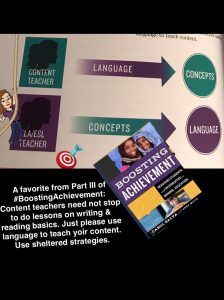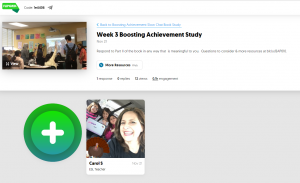Take a peek into an effective science classroom for newcomers. As always, the book study questions are at the bottom of this post.
You can listen to the show right here:
Listen to “BAP011 Teaching Science Successfully to Newcomers with Michele Cooper” on Spreaker.
 This week we have Michele Cooper on the podcast to discuss how she teaches grade level science concepts to students who are new to the language! Michele is a science teacher at a newcomer center at Cardiff Jr. High. She shares what is working for her and we both talk about what we have seen that can propel the science and language of English learners (and all students).
This week we have Michele Cooper on the podcast to discuss how she teaches grade level science concepts to students who are new to the language! Michele is a science teacher at a newcomer center at Cardiff Jr. High. She shares what is working for her and we both talk about what we have seen that can propel the science and language of English learners (and all students).
 During the show, we discuss the challenge of keeping up with grade level curriculum pace when you are teaching a class with many non-English speakers. I explain how I keep my mini-lesson to 15 minutes as was taught to me by Leo Gomez when I became a Gomez & Gomez Dual Language Trainer.
During the show, we discuss the challenge of keeping up with grade level curriculum pace when you are teaching a class with many non-English speakers. I explain how I keep my mini-lesson to 15 minutes as was taught to me by Leo Gomez when I became a Gomez & Gomez Dual Language Trainer.
I’m including this graphic to illustrate the small group seating arrangement I describe in the show. If you have students seated thoughtfully for the guided activity, you should be able to keep the mini-lesson at the level of the top 25% of of your class (for language and background). If you are not able to seat students this way, it is still good to keep in mind as we offer students multiple opportunities to work with different partners.
 Michele and I got into a great debate about the main focus of the Science teacher in a newcomer center. My feeling is that the content teacher should be focused on teaching content. I hope teachers are doing that the way Michele does. She uses language to teach science. She just wrote me and said that she feels that she teaches language with science. I know that is true. And she seems GREAT at it!
Michele and I got into a great debate about the main focus of the Science teacher in a newcomer center. My feeling is that the content teacher should be focused on teaching content. I hope teachers are doing that the way Michele does. She uses language to teach science. She just wrote me and said that she feels that she teaches language with science. I know that is true. And she seems GREAT at it!
But I can tell that teachers are stressing how they are supposed to teach all of the English and all of the science our newcomers need. This is where I recommend a solid language objective for every class period. With a solid goal for language, over 180+ days, their English will absolutely move. This #Booksnap from Boosting Achievement is a favorite of many. In Part III of the book, we use it to illustrate that everyone is a language teacher.
So how does this actually look in Michele’s classroom. She gave us a great tip on how she begins her units. She uses Picture Talks by Meredith Alvaro. She explains how she does this and sent along this powerpoint to further illustrate what she explains on the show.
 Loading...
Loading...
At the end of the show Michele comments that one of their newcomers passed the standardized assessment last year for science. She also told me about a different student who passed the reading assessment despite the fact that their intake exams showed them at the beginning levels for reading. We have students who did the same. To me, this is important to highlight because it can change what teachers believe is possible. It can change what students believe is possible. We talk about balancing these stories of success with the fact that our standardized assessments are not the only measure of success. Our ELs need to realize that they get closer to success on those exams every day. They should realize that knowledge about these subjects grows, their English grows and they grow as critical thinkers every day.
Michele lifts up all of her students and reminds us that even students with limited formal education can learn quickly. She also gives examples of how they can contribute to the overall learning of the class. She discusses the practice of sharing the student’s illustrations of grade level content learning. Michele is in a newcomer center but the video above, of Katherine Stokes a Spring Forest Middle School illustrates the same practice in a regular middle school science classroom. In the video, Ms. Stokes is showing anchor charts made by newcomers and students with limited formal education. One of these students spent 14 years in a refugee camp with no running water or electricity. We absolutely need to what we believe is possible for every child.
You can follow Michele Cooper on Twitter at @MsCooperELL. You’ll be so inspired by what she shares:
#Newcomer #7thgradescience students had a great time during #frogdissection Wednesday @CardiffColts pic.twitter.com/XWSiKio6mJ
— Michele Cooper (@MsCooperELL) November 20, 2017
Thank you for being on the show, Ms. Cooper! You are an inspiration!
Where Can We Connect? Find me here:
- Twitter: @MsSalvaC Facebook.com/SalvaBlog LinkedIn
- #BoostingAchievement slow twitter chat book study Nov 6 – Dec 9. Jump in any time. Repeaters welcome. Find all the questions here: bit.ly/BAstudy17. Answer one or just give us your reflections, connections, booksnaps, etc!
- Attending Pathways to Greatness training to Support Newcomers by my mentor Dr. Michelle Yzquierdo, Dec 1, 2017
- Presenting at Region 4 Bilingual/ESL Conference (the students are presenting again!) Dec 15, 2017
- Attending The What’s Working in Texas Conference Jan 25, 2018 #SeidlitzConf
- Presenting at NABE 2018
- Presenting at the Abydos Literacy Conference in April 2018
- March 21 SAVE THE DATE – Using Tech with ELLs Conference in Houston. John Seidlitz and I will present this popular training again!
- Attending ISTE 2018 in Chicago June 24-27th
- BLC18 – Book signing and sharing at Alan November’s Building Learning Communities conference in Boston July 2018
WEEK FOUR of the BOOSTING ACHIEVEMENT BOOK STUDY
Not too late to contribute to the Week 3 Flipgrid! Reflect on any part of the book, in fact. If you’re feeling aprehensive, remember that we ask our ELs to take risks every single day. It is easier than you think:
WEEK 4 QUESTIONS for those who like questions! You can respond on twitter or on Flipgrid. The questions are only a guide. We welcome all ideas, reflections & insight on any part of the book. On social media, please use the hashtag #BoostingAchievement.
This week is about second language acquisition. You may also be interested in the additional resources for Week 4 from the original book study. We have a TON of free PD opportunity there: bit.ly/WeekFourSIFE
4Q1) p. 48 – 49 Watch the video with the QR Code or here: bit.ly/ThematicUnit4ESL. Emmanuel was preliterate in any language but had a strong desire to communicate with the visitor. What language standards for emergent readers were met in preparation for Dr. Babaloa? What else stands out about the video or the story on p. 48?
4Q2) p. 50 What is the difference between learning a language and acquiring a language? Why is the distinction especially important for SIFE?
4Q3) p. 51 & 52 Read US History Experience with Paul Spellman on page 52 that describes how Carol’s Newcomer class prepared for an author visit. This video was made for Dr. Spellman: bit.ly/AuthorVisitPrep Many of the students were compelled to read Dr. Spellman’s book. Why? What else did you notice?
4Q4) p. 58 -59 The content teacher and the ESL teacher use language in different ways. What are your take-aways from this?
4Q5) p. 60 – 61 How is the focus different for the sheltered science teacher vs the ESL teacher who decides to use science in a unit? What stands out to you on these pages?
4Q6) p. 62 Carol explains that English Learners should be assessed according to their level of English language proficiency. We must understand the proficiency descriptors to meet students where they are for language when assessing. But what if that student has not been offered comprehensible input? What can schools do to help content teachers offer comprehensible input to ELs?
4Q7) p. 63 The reality for some learners who are SIFE is that they may not master courses like Algebra I if they do not have the foundational skills necessary for the class. What hope is there for this student? Read page 63 and respond with what the author suggests or other ideas you have for supporting these students.